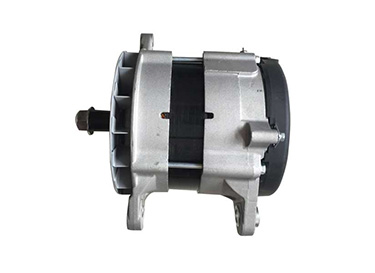Sep. 29, 2020
China Hyundai alternator supplier introduces the working principle of the alternator.
1. Power generation principle
The basic principle of the alternating current generation by an alternator is the principle of electromagnetic induction. When direct current is applied to the rotor winding of the generator, a magnetic field is generated, the rotor is driven by the engine to rotate, and the stator winding cuts the rotor magnetic field to induce a three-phase alternating electromotive force.
2. Principle of rectification
The rectifier circuit converts the three-phase electromotive force into a DC pulsating voltage; because the battery has the function of a capacitor, the output DC voltage waveform is relatively flat.
When the generator is running at no load, neglecting the resistance voltage drop of the three-phase winding and the rectifier, the DC electromotive force is about: U=2.34Eφ (Eφ is the phase electromotive force).
3. Excitation method
The generator rotor winding generates a magnetic field, which is called excitation. The excitation of the generator has two methods: separate excitation and self-excitation.
(1) Ta Li
When the generator speed is low (the engine does not reach the idling speed), it cannot generate electricity by itself, and the battery is required to supply the generator field winding current so that the field winding generates a magnetic field to generate electricity. This method of generating excitation current supplied by the battery is called separate excitation.
(2) Self-incentive
As the speed increases (usually when the engine reaches idling speed), the electromotive force of the generator stator winding gradually rises and can turn on the rectifier diode. When the output voltage of the generator is greater than the battery voltage, the generator can supply external power. At this time, the self-generated electricity can be supplied to the field winding. This self-excitation method of supplying excitation current to generate electricity is called self-excitation power generation.
Working characteristics of the alternator
The working characteristics of the alternator refer to the relationship between the terminal voltage U, the output current I, and the speed n when the generator is working.
1. No-load characteristics
The no-load characteristic refers to the relationship between generator terminal voltage U and speed n when the generator is no-load (ie I=0).
Two, external characteristics
When the generator speed is constant, the output voltage U changes with the output current I.
3. Output characteristics (load characteristics)
When the generator output voltage U is constant (usually a 12V generator remains at 14V), the relationship between the generator load current I and the speed n is called the output characteristic or load characteristic.

Alternator For Trucks
Regulator for Alternator for trucks
The output voltage of the generator is related to the speed of the generator rotor:
Working principle of the voltage regulator
1. Contact voltage regulator
Contact-type voltage regulators were applied earlier. This type of regulator’s contact vibration frequency is slow, there are mechanical inertia and electromagnetic inertia, the voltage adjustment accuracy is low, the contact is prone to sparks, it has large radio interference, poor reliability, and short life. Has been eliminated.
Two, transistor voltage regulator
The transistor voltage regulator uses the switching function of the transistor to control the on and off of the generator's magnetic field circuit to adjust the strength of the magnetic field and keep the terminal voltage unchanged.
Three, integrated circuit voltage regulator
The integrated circuit voltage regulator has the characteristics of small size, strong function, high reliability, simple structure, low cost, etc., and has been widely used in automobiles at home and abroad. Due to their small size, integrated circuit voltage regulators are currently installed in generators and become integral AC generators.
The integrated circuit voltage regulator changes the output voltage of the generator by changing the duty cycle of the magnetic field current.
Navigation
Name: Carrie Zhou
Tel: +023-68886580
WeChat: 0086-13650592877
E-mail: carrie@autopartstf-ws.com
Skype: transfortune
WhatsApp: +86 136 5059 2877
Homepage: www.autopartstf-ws.com